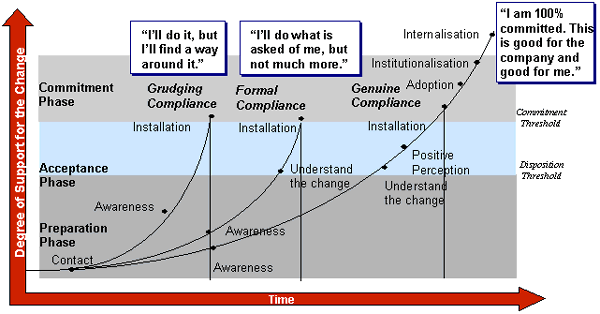[ You may close this window when done ]
Change Readiness
A synthesis prepared by Susan Donnan, March 2006
Change is disruptive
Change threatens people's comfort, control, confidence and competence; resistance is a normal reaction to change. Therefore, in times of change, it is important that we:
- Minimise the period of uncertainty as far as possible.
- Create safe forums for people to voice their issues and concerns.
- Provide relevant information to increase their comfort and control.
- Enhance people's abilities to increase their competence and confidence.
Change Readiness
Change readiness is achieved when those impacted by the change are both willing and able to implement the change.

The above figure by Daryl Conner represents the different stages of change commitment: contact, awareness, understanding the change, positive perception, installation, institutionalisation, and internalisation.
Awareness, understanding, and desire to change come from communication and involvement. The maxim is to involve some of the people all of the time, all of the people some of the time, and communicate to all of the people all of the time.
Knowledge and ability to change come from education and training, leading to positive perception and installation of the change.
Reinforcement for the change comes from incentives for the new behaviours and disincentives for the old behaviours, leading to adoption, institutionalisation and internalisation of the change.
Readiness Assessment
Change readiness can be assessed using one of the following mechanisms:
- Survey questionnaire
- Focus group
- One-on-one meeting
- Informal chat
Regardless of the mechanism used, the following are some of the questions to ask:
- To what degree do you believe in the direction of the change (vision / business strategy)?
- To what degree are you aware of the case for change and the risk of not changing?
- To what degree do you agree with the case for change and the risk of not changing?
- To what degree do you believe that the change objectives are achievable?
- How able are you in implementing the change?
- How satisfied are you with the education and training that you have received on making the change?
- What additional education and training would support you in making the change?
- How satisfied are you with:
- The information you have received on the change project?
- Your involvement in the change project?
- Given that change will happen, how do you wish:
- To participate in the design and implantation of the change?
- To be informed of progress in the design and implementation of the change?
- To what degree are your personal and departmental objectives aligned with the change objectives?
- What are your personal concerns about the change?
Sources of change resistance
People resist change because of one of the following:
- Content - They disagree with what is changing.
- Process - They disagree with how change is being planned, designed, and implemented (e.g. lack of involvement).
- Emotional / psychological - They are concerned about the personal impact of the change.
- Knowledge, experience, and skills - They have the desire to change, but lack the abilities to work in the new way.
Dealing with change resistance
To increase change readiness, the following are some suggestions for dealing with change resistance:
- Lack of awareness - Take the time to provide the relevant information and explanation.
- Lack of agreement - Actively listen to understand the underlying reasons or objections, demonstrate that you understand their point of view, provide your own point of view, and dialogue to reach a workable way forward.
- Lack of abilities - Provide the necessary training to bridge the knowledge and skill gaps.
- Personal concerns - Dispel any misunderstandings and directly address the concerns.
- Lack of motivation ‑ Consider aligning the person's personal or departmental objectives. Be clear on what you expect of the person in terms of actions, behaviours, and results. The more concrete your expectations the better.
- As a last resort ‑ Consider using consequence management. Be clear on the negative consequences of the person's decisions and actions.
References
- Managing at the speed of Change; Daryl R. Conner
- Champions of Change; David A. Nadler
- Change Management; Jeffrey M. Hiatt, Timothy J. Creasey
[ You may close this window when done ]

